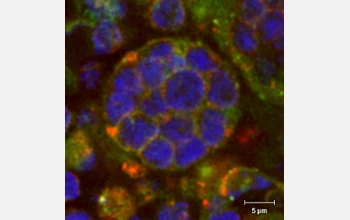News Release 07-059
"Nurse Cells" Make Life and Death Decisions for Infection-Fighting Cells
May 29, 2007
This material is available primarily for archival purposes. Telephone numbers or other contact information may be out of date; please see current contact information at media contacts.
"Nurse cells" play an important role in deciding which developing infection-fighting cells, called T cells, live and which die, according to research funded by the National Science Foundation (NSF) and reported in the June issue of the journal Experimental Biology and Medicine.
The infection-fighting cells, known as thymocytes or T cells, live in the thymus, an organ in the upper portion of the chest. Loss of the thymus results in severe immunodeficiency and increased susceptibility to infection. The function of T cells produced by the thymus is to recognize harmful invaders. Once invaders have been identified, T cells then attempt to eliminate disease-infected cells.
"In early studies, it was suggested that thymic nurse cells only removed non-functional thymocytes," said Eve Barak, program director in NSF's Division of Molecular and Cellular Biology. "This research shows that nurse cells are performing a much bigger role in the thymus than we thought."
Thymic nurse cells were given their name because of their close relationship with thymocytes. These nurse cells have been reported to take up as many as 50 destined-to-die thymocytes into their own cell bodies.
Thymic nurse cells were discovered in 1980. Their existence was debated because many scientists found it difficult to believe that a cell could internalize another cell, said Jerry Guyden, a biologist at the City College of New York and lead researcher.
The thymus is present in most vertebrates, with a similar structure and function as the human thymus. Animal thymic tissue sold in butcher shops or at meat counters is known as sweetbread.
-NSF-
Media Contacts
Cheryl Dybas, NSF, (703) 292-7734, email: cdybas@nsf.gov
The U.S. National Science Foundation propels the nation forward by advancing fundamental research in all fields of science and engineering. NSF supports research and people by providing facilities, instruments and funding to support their ingenuity and sustain the U.S. as a global leader in research and innovation. With a fiscal year 2023 budget of $9.5 billion, NSF funds reach all 50 states through grants to nearly 2,000 colleges, universities and institutions. Each year, NSF receives more than 40,000 competitive proposals and makes about 11,000 new awards. Those awards include support for cooperative research with industry, Arctic and Antarctic research and operations, and U.S. participation in international scientific efforts.
Connect with us online
NSF website: nsf.gov
NSF News: nsf.gov/news
For News Media: nsf.gov/news/newsroom
Statistics: nsf.gov/statistics/
Awards database: nsf.gov/awardsearch/
Follow us on social
Twitter: twitter.com/NSF
Facebook: facebook.com/US.NSF
Instagram: instagram.com/nsfgov



